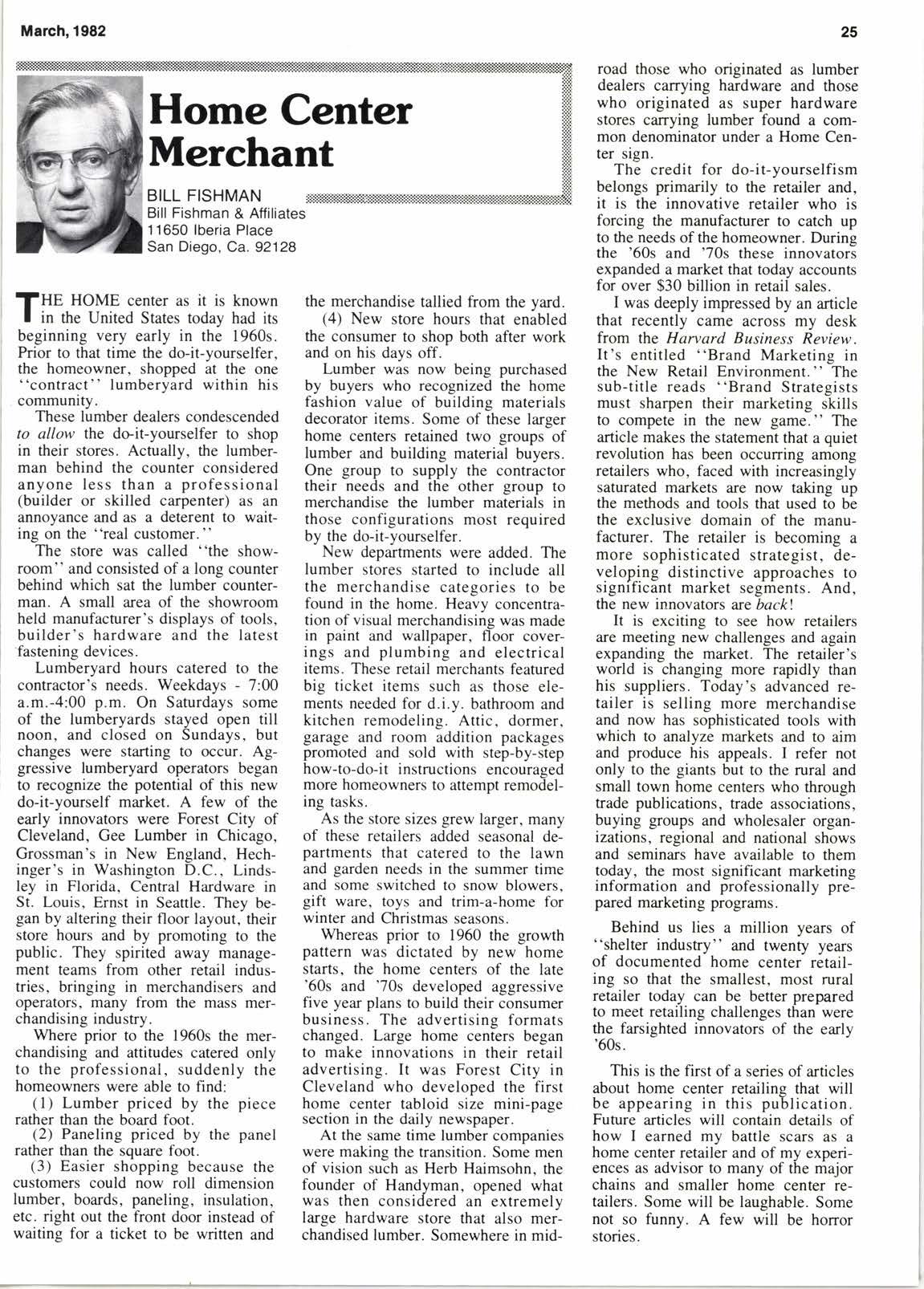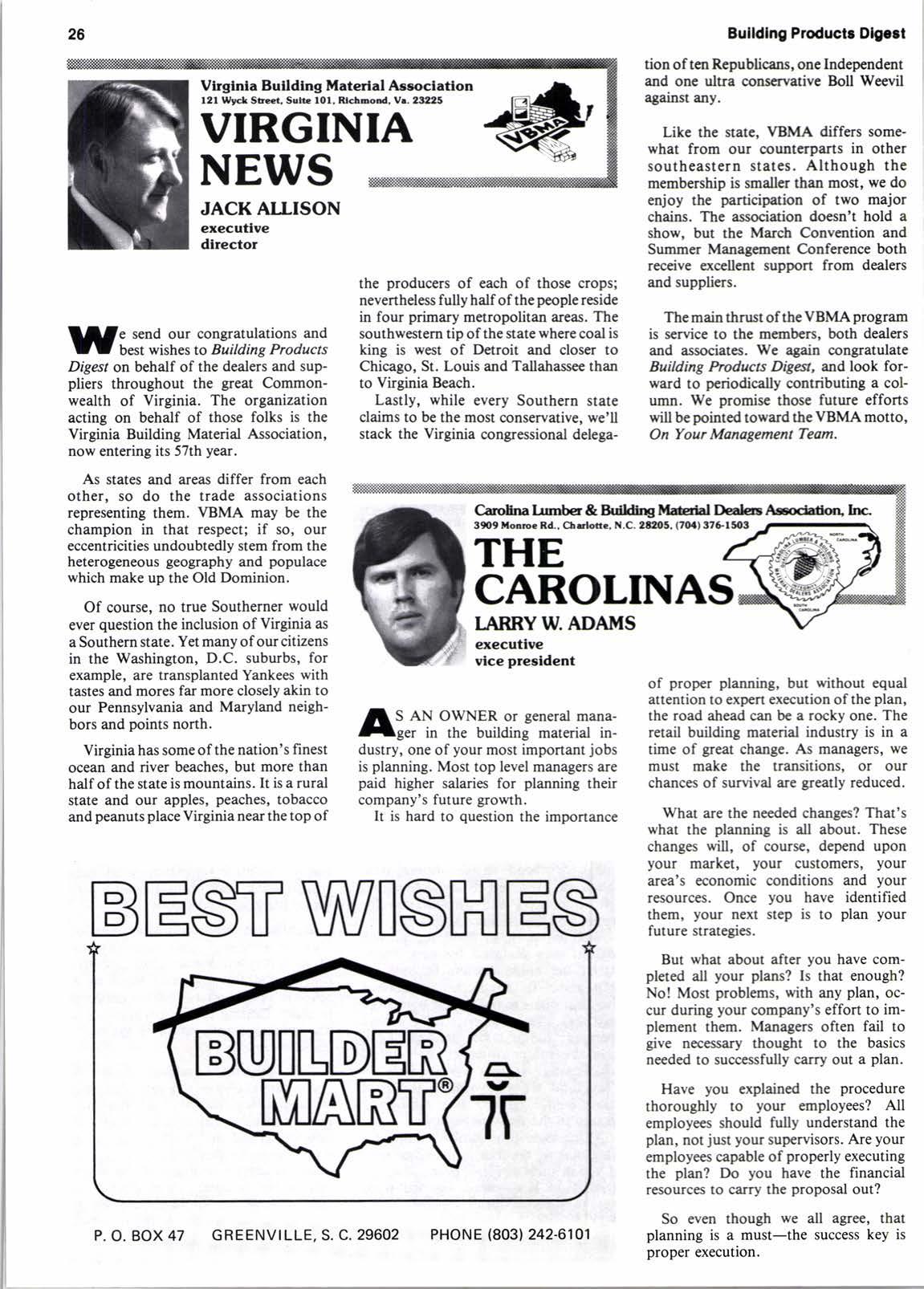
6 minute read
Home Center Merchant
Bill Fishman
Bill Fishman & Affiliates
11650 lberia Place
San Diego, Ca.92128
THE HOME center as it is known I in the United States today had its beginning very early in the 1960s. Prior to that time the do-iryourselfer, the homeowner, shopped at the one "contract" lumberyard within his community.
These lumber dealers condescended to allow the do-it-yourselfer to shop in their stores. Actually, the lumberman behind the counter considered anyone less than a professional (builder or skilled carpenter) as an annoyance and as a deterent to waiting on the "real customer. "
The store was called "the showroom" and consisted of a long counter behind which sat the lumber counterman. A small area of the showroom held manufacturer's displays of tools, builder's hardware and the latest 'fastening devices.
Lumberyard hours catered to the contractor's needs. Weekdays - 7:00 a.m.-4:00 p.m. On Saturdays some of the lumberyards stayed open till noon, and closed on Sundays, but changes were starting to occur. Aggressive lumberyard opefators began to recognize the potential of this new do-it-yourself market. A few of the early innovators were Forest City of Cleveland, Gee Lumber in Chicago, Grossman's in New England, Hechinger's in Washington D.C., Lindsley in Florida, Central Hardware in St. Louis, Ernst in Seattle. They began by altering their floor layout, their store hours and by promoting to the public. They spirited away management teams from other retail industries, bringing in merchandisers and operators, many from the mass merchandising industry.
Where prior to the 1960s the merchandising and attitudes catered only to the professional, suddenly the homeowners were able to find:
(l) Lumber priced by the piece rather than the board foot.
(2) Paneling priced by the panel rather than the square foot.
(3) Easier shopping because the customers could now roll dimension Iumber, boards, paneling, insulation, etc. right out the front door instead of waiting for a ticket to be written and the merchandise tallied from the yard.
(4) New store hours that enabled the consumer to shop both after work and on his days off.
Lumber was now being purchased by buyers who recognized the home fashion value of building materials decorator items. Some of these larger home centers retained two groups of lumber and building material buyers. One group to supply the contractor their needs and the other group to merchandise the lumber materials in those configurations most required by the do-iryourselfer.
New departments were added. The lumber stores started to include all the merchandise categories to be found in the home. Heavy concentration of visual merchandisins was made in paint and wallpaper, fl--oor coverings and plumbing and electrical items. These retail merchants featured big ticket items such as those elements needed for d.i.y. bathroom and kitchen remodeling. Attic, dormer, garage and room addition packages promoted and sold with step-by-step how-to-do-it instructions encourased more homeowners to attempt remodeling tasks.
As the store sizes grew larger, many of these retailers added seasonal departments that catered to the lawn and garden needs in the summer time and some switched to snow blowers, gift ware, toys and trim-a-home for winter and Christmas seasons.
Whereas prior to 1960 the growth pattern was dictated by new home starts, the home centers of the late '60s and '70s developed aggressive five year plans to build their consumer business. The advertisins formats changed. Large home ceniers began to make innovations in their retail advertising. It was Forest City in Cleveland who developed the first home center tabloid size mini-page section in the daily newspaper.
At the same time lumber companies were making the transition. Some men of vision such as Herb Haimsohn, the founder of Handyman, opened what was then considered an extremely large hardware store that also merchandised lumber. Somewhere in mid- road those who originated as lumber dealers canying haidware and those who originated as super hardware stores carrying lumber found a common denominator under a Home Center sien.
Th6 credit for do-it-yourselfism belongs primarily to the retailer and, it is the innovative retailer who is forcing the manufacturer to catch up to the needs of the homeowner. Durins the '60s and '70s these innovatori expanded a market that today accounts for over $30 billion in retail sales.
I was deeply impressed by an article that recently came across my desk from the Harvard Business Review. It's entitled "Brand Marketine in the New Retail Environment. " -ttre sub-title reads "Brand Strategists must sharpen their marketing skills to compete in the new game." The article makes the statement that a quiet revolution has been occurring among retailers who, faced with increasingly saturated markets are now taking up the methods and tools that used to be the exclusive domain of the manufacturer. The retailer is becoming a more sophisticated strategist, developins distinctive aDDroaches to significlnt market segnients. And. the new innovators are backl
It is exciting to see how retailers are meeting new challenges and again expanding the market. The retailer's world is changing more rapidly than his suppliers. Today's advanced retailer is selling more merchandise and now has sophisticated tools with which to analyze markets and to aim and produce his appeals. I refer not only to the giants but to the rural and small town home centers who throush trade publications, trade association-s, buying groups and wholesaler organizations, regional and national shows and seminars have available to them today, the most significant marketing information and professionally prepared marketing programs.
Behind us lies a million years of "shelter industry" and twenty years of documented home center retailing so that the smallest, most rural retailer today can be better prepared to meet retailing challenges than were the farsighted innovators of the early '60s.
This is the lrst of a series of articles about home center retailins that will be appearing in this publication. Future articles will contain details of how I earned my battle scars as a home center retailer and of my experiences as advisor to many of the major chains and smaller home center retailers. Some will be laughable. Some not so funny. A few will be honor stories.
JACK AIIISON exeicutlve dlrector
W;X",l,,i::,$ffii#'B:)#*
Digest on behalf of the dealers and suppliers throughout the great Commonwealth of Virginia. The organization acting on behalf of those folks is the Virginia Building Material Association, now €ntering its 57th year.

As states and areas differ from each other, so do the trade associations representing them. VBMA may be the champion in that respect; if so, our eccentricities undoubtedly stern from the heterogeneous geography and populace which make up the Old Dominion.
Of course, no true Southerner would ever question the inclusion of Virginia as a Southern state. Yet many of our citizens in the Washington, D.C. suburbs, for example, are transplanted Yankees with tastes and mores far more closely akin to our Pennsylvania and Maryland neigltbors and points north.
Virginiahas someof the nation's finest ocean and river beaches, but more than half of the state is mountains. It is a rural state and our apples, peaches, tobacco and peanuts place Virginianearthe top of the producers of each of those crops; nevertheless fullyhalf of thepcople reside in four primary metropolitan areas. The southwestern tip of the state where coal is king is west of Detroit and closer to Chicago, St. Louis and Tallahassce than to Virginia Beach.
Lastly, while every Southern state clairns to be the most conscrvative, we'll stack the Virginia congressional delega- tion of tcn Rcpublicans, onc Independcnt and one ultra conscrvativc Boll Weevil rgqinst 3ny.
Like the statc, VBMA differs somewhat from our oountcrparts in other southeastern statcs. Although the mcmbcrship is smallcr than most, we do enjoy thc participation of two major chains. Thc association docsn't hold a show, but the March Convention and $rrmm€r Uanagcncot Conference both receive cxellent support from dealers and supplicrs.
The main thrust of thc VBMA program is servicc to the mcmbcrs, both dealers and associatcs. \Vs egain congratulate Building Mucts Diga, and look forward to pcriodically contributing a colnmn. We promisc thosc future efforts will be pointcd toward thc VBMA motto, On Your Monogemmt Teon.
jT',lif#dld?T*t-";:
dustry, one of your most important jobs is planning. Most top level managers are paid higher salaries for planning their company's future grofih.
It is hard to question the importance of proper planning, but without equal attention to expert execution ofthe plan, the road ahead can be a rocky one. The retail building material industry is in a t:me of great change. As managers, we must make the transitions, or our chances of survival are greatly reduced.
Wbu are the needed changes? That's what the planning is all about. These changes will, of course, depend upon your market, you customers, your area's economic conditions and your resouroes. Once you have identified them, your next $ep is to plan your future strategi€s.
But what about after you have completed all your plans? Is that enough? No! Most problems, with any plan, occur during your oompany's effort to implerrent them. Managers often fail to give necessary thought to the basics needed to successfully carry out a plan.
Have you cxplained the procedure thoroughly to your cmployees? All employees should fully understand the plan, not just your supervisors. Are your employees capable of properly executing the plan? Do you have the financial resources to carry the proposal out?
So wen thougft we all agree, that planning is a must-the success key is proper execution.










